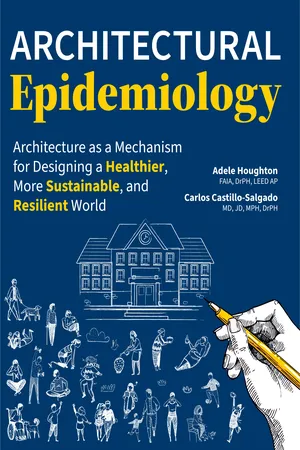
Architectural Epidemiology
Architecture as a Mechanism for Designing a Healthier, More Sustainable, and Resilient World
- English
- ePUB (mobile friendly)
- Available on iOS & Android
Architectural Epidemiology
Architecture as a Mechanism for Designing a Healthier, More Sustainable, and Resilient World
About this book
How to create healthier, sustainable, and resilient communities using place-based design strategies.
In a world where real estate development often overlooks the critical link between our built environment and public health, architectural epidemiology has emerged as a groundbreaking field that reimagines how to design, build, and inhabit our spaces. Adele Houghton and Carlos Castillo-Salgado bridge the gap between two disparate fields to propose a new, transdisciplinary approach aimed at fostering community and planetary health.
Architectural Epidemiology leverages building design, renovation, and operations to improve health outcomes among building occupants and in the surrounding community. Drawing from both environmental and applied social epidemiology, this novel approach deploys a problem-solving methodology to identify the evidence-based strategies in building design and operations that could lead to positive or negative health outcomes by reducing exposure to environmental hazards and promoting healthy behaviors. The authors illustrate how thoughtful, place-based design can mitigate the adverse effects of climate change, chronic diseases, and other public health challenges. Real-world examples from diverse settings demonstrate the practical application of architectural epidemiology and its impacts on community and planetary health. Practical tools and infographics translate complex scientific data into actionable design strategies, helping professionals from various disciplines collaborate effectively.
The principles and applications of architectural epidemiology can drive meaningful action on climate change, sustainable development, and environmental justice while improving public health outcomes and transforming our built environment into a healthier, more equitable world.
Frequently asked questions
- Essential is ideal for learners and professionals who enjoy exploring a wide range of subjects. Access the Essential Library with 800,000+ trusted titles and best-sellers across business, personal growth, and the humanities. Includes unlimited reading time and Standard Read Aloud voice.
- Complete: Perfect for advanced learners and researchers needing full, unrestricted access. Unlock 1.4M+ books across hundreds of subjects, including academic and specialized titles. The Complete Plan also includes advanced features like Premium Read Aloud and Research Assistant.
Please note we cannot support devices running on iOS 13 and Android 7 or earlier. Learn more about using the app.
Information
Table of contents
- Cover
- Halftitle
- Title Page
- Copyright Page
- Contents
- List of Figures
- Advice for Using This Book
- Online Supplement
- Acknowledgments
- Halftitle 01
- Introduction
- Chapter 1 An Introduction to Architectural Epidemiology
- Chapter 2 Introduction to Metrics for Built Environment Professionals
- Architectural Epidemiology Toolbox
- Chapter 3 Architectural Epidemiology at Each Phase of the Project Delivery Process
- Chapter 4 Applying Architectural Epidemiology to Different Contract and Financing Structures
- Chapter 5 Looking Ahead to the Future of Architectural Epidemiology
- Glossary
- Index
- Promo Page